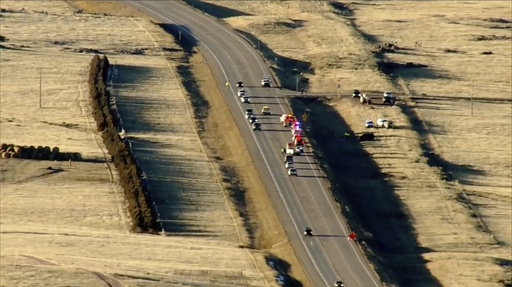CHEYENNE, Wyo. (AP) — Three members of the University of Wyoming swimming and diving team were killed and two others injured when their sport utility vehicle veered and rolled over alongside a rural highway, bringing to at least 15 the school’s students killed in recent years on the perilous road.
The latest crash happened Thursday afternoon on U.S. 287 about 10 miles (16 kilometers) south of the Wyoming-Colorado line between Laramie, Wyoming, and Fort Collins, Colorado.
The crash happened when the Toyota RAV4 SUV with five people inside swerved and went off the pavement, and the vehicle rolled over multiple times.
Two people were ejected. The crash killed Charlie Clark, 19, a sophomore psychology major from Las Vegas; Luke Slabber, 21, a junior studying construction management from Cape Town, South Africa; and Carson Muir, 18, a freshman on the women’s swimming and diving team and an animal and veterinary sciences major from Birmingham, Alabama, according to the university.
The two injured team members, including the driver, were released from the hospital Friday, according to a Colorado State Patrol statement that did not identify the survivors.
The driver may have been avoiding a vehicle ahead that had slowed, possibly to make a turn, according to the state patrol statement.
The accident was still being investigated. Possible causes including driving too fast, impairment and distractions were not being ruled out, the statement says.
Two people were ejected from the vehicle but the statement didn’t say who they were or whether they were wearing seat belts. The SUV was headed south and not on an official team trip, according to the patrol.
“We are heartsick at the news of this terrible tragedy for our university, our state, our student-athlete community and, most importantly, the families and friends of these young people,” University of Wyoming President Ed Seidel said in the statement.
The crash happened as others on the team competed at the Mountain West Swimming & Diving Championships in Houston. Swimmers from Colorado State University in Fort Collins honored their Wyoming rivals at the meet with the Wyoming logo and “WYO” with a heart drawn on their skin.
The weather was fair and conditions clear at the time on the often busy, two- and three-lane highway that winds through the scenic Rocky Mountain foothills. Typical hazards include blind curves, wildlife, passing vehicles and traffic entering and exiting at intersections.
University of Wyoming students often travel the road for shopping, socializing and entertainment in Fort Collins and Denver.
In 2001, a head-on crash with a drunken driver on the same highway killed eight members of the University of Wyoming cross-country team.
In that crash days after the Sept. 11 terrorist attacks, Clint Haskins, a University of Wyoming student, swerved into the lane in front of the athletes’ northbound SUV.
Haskins was the only survivor of the crash 15 miles (24 kilometers) south of Laramie and pleaded guilty to aggravated vehicular homicide. He was paroled after 9 1/2 years in prison.
The crash shocked the state and helped lead to safety improvements on the highway in Wyoming.
In 2010, a pickup truck drifted off the highway in Colorado and rolled over, killing a 19-year-old University of Wyoming football player and injuring three teammates.
In 2021, three University of Wyoming students were killed when their car slid on icy pavement and was struck by an oncoming vehicle near the scene of Thursday’s wreck.
Portions of the road in Colorado have above-average crash rates, making the highway a good candidate for more safety improvements, according to a summary of a 2023 Colorado Department of Transportation report. The report has not yet been made public.
The same 30-mile (48-kilometer) section from north of Fort Collins to the Wyoming line where the crash occurred Thursday has had 570 crashes, including 15 fatal wrecks, in the past five years, according to the summary.
This website uses cookies so that we can provide you with the best user experience possible. Cookie information is stored in your browser and performs functions such as recognising you when you return to our website and helping our team to understand which sections of the website you find most interesting and useful.
